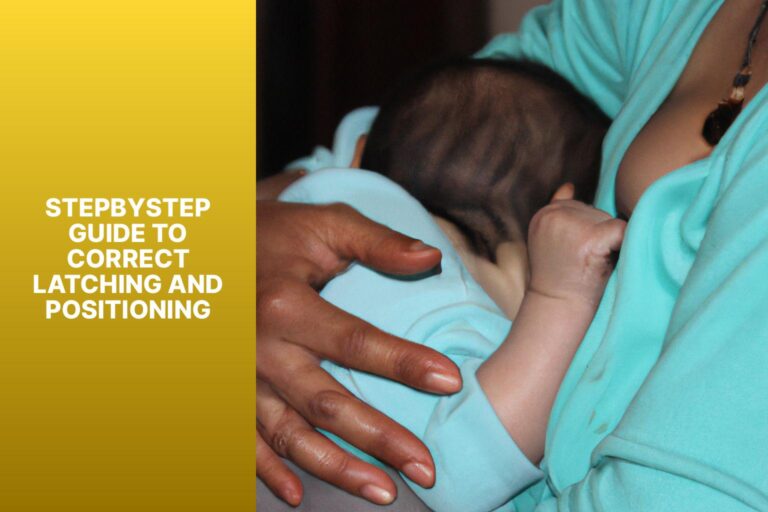Breastfeeding Latch and Positioning Tips for New Moms
Breastfeeding is a crucial aspect of a newborn’s care, providing them with essential nutrients and fostering a strong bond between mother and child. However, achieving a good latch and positioning during breastfeeding can sometimes be challenging for new moms. It is important to understand the significance of a good latch, different breastfeeding positions, and tips to ensure successful breastfeeding. A reputable source, the American Academy of Pediatrics, emphasizes the importance of a good latch for effective milk transfer and preventing nipple soreness.
Common breastfeeding positions include the cradle hold, cross-cradle hold, football hold, and side-lying position, each offering benefits for both mom and baby. To achieve a good latch, it is essential to ensure proper alignment, aim for a deep latch, evaluate the baby’s mouth and jaw, and provide support to the breast. Recognizing signs of a poor latch, such as painful feeding, clicking sounds, or insufficient milk transfer, is crucial in addressing any latching issues.
Several common latching issues, such as flat or inverted nipples, engorgement, tongue tie, or breastfeeding after a C-section, can be effectively addressed with proper guidance and support. Seeking support from healthcare professionals, lactation consultants, and breastfeeding support groups can greatly assist new moms in overcoming any breastfeeding challenges and ensuring a successful breastfeeding journey.
By understanding the importance of a good latch, exploring different breastfeeding positions, and following helpful tips, new moms can navigate the world of breastfeeding with confidence and provide their babies with the nourishment they need.
The Importance of a Good Latch
A good latch is crucial for successful breastfeeding. Here are a few reasons why a good latch is important:
- Effective Milk Transfer: A proper latch ensures that your baby is able to effectively remove milk from your breast. This allows for an adequate milk supply and helps prevent issues like low milk production.
- Preventing Sore Nipples: A good latch helps prevent sore nipples. When your baby latches correctly, their mouth covers a large portion of the areola, which distributes the pressure evenly and reduces friction on the nipple.
- Milk Flow: A proper latch helps create a strong and consistent flow of milk. When the baby effectively latches, they are able to create a vacuum that stimulates milk flow and ensures a continuous supply for the baby.
- Comfortable Feeding: A good latch leads to a comfortable feeding experience for both the mother and the baby. When the latch is correct, the baby can easily suckle and swallow without causing discomfort or frustration.
- Weight Gain: A strong latch ensures that the baby is getting enough milk, which is essential for healthy weight gain. When the baby is latched properly, they are able to efficiently consume the necessary nutrients for growth and development.
- Bonding: A good latch promotes bonding between the mother and the baby. It allows for skin-to-skin contact, eye contact, and the release of hormones that enhance the emotional connection between the two.
By understanding the importance of a good latch, new moms can focus on achieving a proper latch and seeking assistance from lactation consultants or healthcare professionals if needed. This will help ensure a positive breastfeeding experience for both the mother and the baby.
Common Breastfeeding Positions
Finding the right breastfeeding position is key for new moms to ensure a comfortable and successful breastfeeding experience. In this section, we will explore the most common breastfeeding positions, including the cradle hold, cross-cradle hold, football hold, and side-lying position. Each position offers its own unique benefits and challenges, allowing you to find the one that works best for you and your baby. Let’s dive in and discover the secrets to achieving a comfortable and effective latch!
Cradle Hold
The cradle hold is a common breastfeeding position that provides comfort and support for both the mother and the baby. Here are the steps to achieve the cradle hold:
Remember, each breastfeeding position has its benefits, and it may take some experimentation to find the one that works best for you and your baby. Seek assistance from a lactation consultant or breastfeeding support group if you encounter any difficulties with the cradle hold or positioning.
Cross-Cradle Hold
The Cross-Cradle Hold is a popular breastfeeding position that allows for better control and support of the baby during feeding. To achieve the Cross-Cradle Hold, follow these steps:
- Sit in a comfortable chair with good back support.
- Hold your baby in your arm on the side you plan to breastfeed.
- Use the hand on the opposite side to support your breast and guide your baby’s head to your nipple.
- Align your baby’s nose to your nipple, ensuring that their head and body are facing you.
- Use your hand to support your baby’s neck and shoulders, keeping them secure and close to your body.
- Bring your baby’s mouth close to your breast, ensuring a wide open mouth to achieve a deep latch.
- Gently bring your baby’s lower lip and chin to touch your breast first, followed by the upper lip.
- Allow your baby to latch onto your breast, taking in as much of the areola as possible.
The Cross-Cradle Hold is particularly beneficial for newborns or premature babies who may need more support and guidance during feeding. It allows for better control and positioning, ensuring a proper latch and effective milk transfer.
The Cross-Cradle Hold has been widely practiced for generations and is known for its benefits in helping babies latch and feed successfully. This position allows for close bonding between mother and baby, as well as proper alignment of the baby’s body for optimal nursing. It has been proven to be a helpful technique for new mothers who may be navigating the challenges of breastfeeding for the first time. By following these steps, mothers can enhance their breastfeeding experience and provide their babies with the nourishment they need to thrive.
Football Hold
- The football hold is a common breastfeeding position that can be helpful for new moms.
- Here are the steps to achieve the football hold:
- Sit in a comfortable chair with good back support.
- Place a nursing pillow or rolled-up blanket on your lap to support your baby.
- Hold your baby’s head in one hand and their body in the other, with their feet pointing towards your back.
- Position your baby at your side, with their face and body turned towards your breast.
- Bring your baby’s mouth to your breast, making sure their nose is level with your nipple.
- The football hold can be beneficial for mothers with larger breasts, mothers who had a C-section, or babies who struggle with latching.
- It allows for better visibility of the latch and can relieve pressure from the incision site.
Remember to always support your breast with your hand to ensure a deep latch and proper milk transfer. Seek support from a lactation consultant if you experience any difficulties or discomfort while using the football hold.
Side-Lying Position
The side-lying position is a popular breastfeeding position that offers comfort and convenience for both the mother and the baby.
- Comfort: The side-lying position allows the mother to lie on her side, providing support and relaxation for her body. This position is especially beneficial for mothers recovering from a c-section or other childbirth-related discomfort.
- Baby’s comfort: In the side-lying position, the baby lies facing the mother’s body, ensuring a close and intimate connection. The baby can easily find the breast and latch on, promoting a successful breastfeeding session.
- Convenience: This position is ideal for nighttime feedings as it allows both the mother and the baby to remain lying down, promoting a peaceful and restful atmosphere.
- Increased milk flow: The side-lying position allows gravity to assist in milk flow, providing easier access to the breast for the baby. This can be particularly helpful if the baby has a weakened suck or if the mother has an oversupply of milk.
- Bonding: The side-lying position allows for skin-to-skin contact between the mother and the baby, promoting bonding and emotional connection.
By considering the benefits of the side-lying position, mothers can find a comfortable and effective breastfeeding position that suits their needs and promotes a positive breastfeeding experience.
Tips for Achieving a Good Latch
Mastering the art of breastfeeding requires getting the perfect latch, and in this section, we’ll delve into some valuable tips to achieve just that. From ensuring proper alignment to evaluating your baby’s mouth and jaw, we’ll cover all the important factors that contribute to a successful latch. Plus, we’ll explore how supporting the breast plays a vital role in facilitating comfortable and effective nursing. Get ready to enhance your breastfeeding journey with these essential tips!
Ensure Proper Alignment
Proper alignment is crucial for a successful breastfeeding latch.
1. Ensure you position yourself comfortably, ensuring your back is supported and you are relaxed.
2. Bring your baby close, aligning their nose to the nipple, and ensuring their mouth is wide open.
3. Hold your breast with your hand, placing your thumb on top and fingers below, to ensure proper alignment.
4. Gently touch your baby’s lips with your nipple, prompting them to open wider and maintain proper alignment.
5. As your baby’s mouth opens, bring them towards your breast, aiming their bottom lip below the nipple to maintain proper alignment.
6. Make sure your baby’s mouth covers a large portion of the areola, not just the nipple, to maintain proper alignment.
7. Check for proper alignment by observing your baby’s lips, which should be flanged outward.
8. If you notice any discomfort or pain during feeding, reposition your baby for a better alignment to ensure proper breastfeeding.
Remember, ensuring proper alignment during breastfeeding helps prevent nipple soreness and promotes optimal milk transfer. Seek assistance from a lactation consultant if you encounter difficulties achieving proper alignment. With practice and support, you and your baby can establish a successful breastfeeding latch.
Aim for a Deep Latch
- To aim for a deep latch while breastfeeding, follow these steps:
- Position yourself comfortably with support for your back and arms.
- Bring your baby close to your chest, aligning their nose with your nipple.
- Tickle your baby’s lips with your nipple to encourage them to open wide.
- As your baby opens wide, bring them quickly and directly onto your breast.
- Ensure that your baby takes in a good mouthful of breast tissue, not just the nipple.
- Check that your baby’s lips are flanged outwards, covering a large portion of the areola.
- Make sure your baby’s chin is touching your breast and their nose is free for breathing.
- Listen for rhythmic sucking and swallowing sounds, indicating that your baby is latched well.
- To aim for a deep latch, it is important to remember:
- A deep latch helps your baby effectively remove milk from your breast and promotes adequate milk supply.
- A shallow latch may cause nipple pain, poor milk transfer, and reduced milk supply.
- You may need to adjust your positioning or seek assistance from a lactation consultant if you’re having difficulty achieving a deep latch.
- Regularly monitor your baby’s feeding patterns and their overall well-being to ensure they are getting enough milk.
- Remember, a deep latch is essential for successful breastfeeding and the well-being of both you and your baby.
Evaluate Baby’s Mouth and Jaw
When evaluating the baby’s mouth and jaw during breastfeeding, it is important to consider several key factors:
- Check for a wide gape: Evaluate whether the baby’s mouth is open wide, with the lower lip turned outwards. This ensures a deep latch and effective milk transfer.
- Observe the position of the tongue: Assess whether the baby’s tongue is positioned under the breast, covering the lower gumline. This creates a seal and helps to draw the milk out.
- Look for proper alignment: Examine if the baby’s nose is in line with the nipple, and their chin is touching the breast. This helps ensure that the baby can breathe comfortably while breastfeeding.
- Assess the movement of the jaw: Evaluate if the baby’s jaw moves rhythmically as they suckle, with a smooth up and down motion. This indicates that they are effectively extracting milk from the breast.
By evaluating the baby’s mouth and jaw during breastfeeding, you can ensure that they are latched correctly and receiving milk efficiently. This evaluation is crucial to preventing nipple pain, promoting an adequate milk supply, and supporting successful breastfeeding.
True story: Emily, a first-time mother, faced challenges with her baby’s latch in the early weeks of breastfeeding. She noticed that her baby’s mouth appeared shallow, and their jaw movements seemed hesitant. Emily reached out to a lactation consultant who evaluated her baby’s mouth and jaw. The consultant assisted her in positioning the baby correctly, ensuring a deeper latch and better milk transfer. With this valuable support, Emily and her baby were able to establish a successful breastfeeding relationship.
Support the Breast
When it comes to breastfeeding, proper support of the breast is essential for a successful latch. Here are some tips to support the breast during breastfeeding:
- Use a breastfeeding pillow or regular pillows to elevate and support the breast to the height of your breast.
- Hold your breast with your hand in a “C” shape, placing your fingers underneath the breast and the thumb on top, a few centimeters away from your baby’s mouth.
- Ensure that your fingers are positioned behind the areola (the dark area around the nipple) to provide support and help your baby take a deep latch.
- Gently pull back on the breast tissue to make it easier for your baby to latch onto the breast.
- Keep your fingers relaxed and avoid putting pressure on the breast, as this can make it difficult for your baby to latch and may cause discomfort for you.
- After your baby has latched, continue to support the breast with your hand to maintain a good latch throughout the feeding.
- If you are experiencing discomfort or pain during breastfeeding, adjust your baby’s position and the way you support your breast to ensure a comfortable and effective latch.
- Remember to switch sides during each feeding session to provide equal stimulation to both breasts and maintain a good milk supply.
Properly supporting the breast during breastfeeding can help ensure a comfortable and effective latch, leading to a satisfying feeding experience for both you and your baby.
Signs of a Poor Latch
If your breastfeeding experience is causing discomfort or frustration, don’t fret. In this section, we’ll dive into the signs of a poor latch, giving you insights into what might be going wrong. From painful feeding to clicking sounds or noisy feeding, and even insufficient milk transfer, we’ll uncover these common issues and provide you with the knowledge you need to improve your breastfeeding journey. So, let’s tackle these challenges head-on and make breastfeeding a more comfortable and successful experience for both you and your little one!
Painful Feeding
- Ensure proper positioning: Make sure you are in a comfortable position and that your baby is properly aligned with your breast to address painful feeding.
- Check latch technique: Ensure that your baby has a deep latch, with their mouth covering a large portion of your areola, to alleviate painful feeding.
- Assess baby’s mouth and jaw: Check for any signs of tongue tie or other issues that may be causing painful feeding to address the issue.
- Seek help from a lactation consultant: If you are experiencing consistent pain while breastfeeding, it may be beneficial to seek assistance from a certified lactation consultant to address painful feeding.
- Treat any underlying issues: If the pain persists, it is important to address any underlying issues such as thrush, nipple trauma, or mastitis to alleviate painful feeding.
- Take breaks and rest: It is important to take breaks and rest when needed, especially if you are experiencing pain during breastfeeding to alleviate painful feeding.
- Use nipple cream: Applying nipple cream or lanolin can help with soothing and healing any soreness or discomfort caused by painful feeding.
Painful feeding can be a common concern for breastfeeding mothers. By following these steps, you can help alleviate and address the issue, ensuring a more comfortable breastfeeding experience for both you and your baby.
Clicking Sounds or Noisy Feeding
When breastfeeding, hearing clicking sounds or experiencing noisy feeding can be a sign of an improper latch. Here are some steps to address the issue of clicking sounds or noisy feeding:
- Reposition the baby: Gently unlatch the baby and try repositioning them to ensure a deeper latch.
- Check for proper mouth and jaw alignment: Make sure the baby’s lips are flanged outward, covering a large portion of the areola, and their tongue is cupping the breast.
- Relatch with a wider mouth: Encourage the baby to open their mouth wider before latching on to improve the latch and reduce clicking sounds.
- Check for tongue tie: If the issue of clicking sounds or noisy feeding persists, consult with a lactation specialist or healthcare provider to check for tongue tie, which can affect proper latch and milk transfer.
- Ensure a calm and relaxed feeding environment: Minimize distractions and create a peaceful setting to help the baby focus on feeding without distractions.
Remember, a good latch is essential for efficient milk transfer and a comfortable feeding experience for both mother and baby. If clicking sounds or noisy feeding continues despite attempting these steps, seeking support from a lactation consultant or healthcare professional can provide further guidance and assistance.
Insufficient Milk Transfer
Inadequate milk transfer can be a common issue while breastfeeding. Here are some steps to address this problem:
Check the latch: Ensure that the baby’s mouth is properly attached to the breast. A deep latch is crucial for effective milk transfer.
Positioning: Use breastfeeding positions that allow your baby’s mouth to be aligned with your nipple. The cradle hold or cross-cradle hold are good options.
Encourage active sucking: Gently massage your breast to stimulate milk flow and encourage your baby to actively suckle.
Try breast compression: While your baby is latched, gently compress your breast to help increase milk flow and encourage better milk transfer.
Switch sides: If you notice insufficient milk transfer on one side, switch to the other breast to ensure both breasts are adequately emptied.
In cases of persistent insufficient milk transfer, it’s important to seek guidance from a lactation consultant or healthcare professional. They can provide personalized advice and support tailored to your specific circumstances. Remember, every breastfeeding journey is unique, and seeking help is an important step towards overcoming challenges and ensuring the best possible breastfeeding experience for both you and your baby.
Troubleshooting Common Latching Issues
Having trouble with breastfeeding? This section dives into troubleshooting common latching issues, addressing concerns like flat or inverted nipples, engorgement, tongue tie, and breastfeeding after a C-section. Get ready to overcome these hurdles for a smooth and successful breastfeeding journey. No need to worry, we’ve got you covered with tips and strategies to ensure a comfortable and nourishing experience for both you and your little one. Let’s tackle these common challenges head-on!
Flat or Inverted Nipples
When dealing with flat or inverted nipples, here are some tips to help with breastfeeding:
- Break the suction: Before latching, gently compress the breast to break the suction and make it easier for the baby to latch.
- Use a breast pump: To temporarily draw out the nipple, try using a breast pump for a few minutes before breastfeeding.
- Try nipple shields: Nipple shields can help with latching by providing a protrusion for the baby to grasp onto.
- Seek professional help: Consult with a lactation consultant or healthcare provider for guidance and support in managing flat or inverted nipples.
It’s important to remember that even with flat or inverted nipples, many women are still able to breastfeed successfully. Persistence and patience are key in finding the techniques that work best for you and your baby.
Engorgement
Breast engorgement is a common issue that new moms may face during breastfeeding. Engorgement occurs when the breasts become overly full and swollen with milk. This can cause discomfort and make it difficult for the baby to latch properly.
To alleviate engorgement, there are several steps that can be taken. Expressing a small amount of milk before feeding can help soften the breast and make it easier for the baby to latch. Applying a warm compress or taking a warm shower before feeding can also help with milk flow. It is important to ensure proper positioning and latch during feeding to ensure effective milk transfer and relieve engorgement.
In some cases, engorgement may lead to complications such as mastitis, a breast infection. If symptoms of mastitis develop, such as redness, warmth, or pain in the breast, it is important to seek medical attention.
Breast engorgement is a temporary condition that usually resolves in a few days as the body adjusts to the baby’s feeding patterns. It is important to consult with a lactation consultant or healthcare provider for guidance and support during this time. With proper care and management, engorgement can be successfully addressed, allowing for a more comfortable breastfeeding experience for both the mother and the baby.
Tongue Tie
Tongue tie, also known as ankyloglossia, is a common condition where an infant’s tongue is tethered to the floor of their mouth by a thin tissue called the frenulum. This condition can pose challenges to breastfeeding as it makes it difficult for the baby to properly latch onto the breast.
Breastfeeding can be affected by tongue tie, resulting in problems such as ineffective milk transfer and sore nipples. To address this issue, a simple procedure called frenotomy may be required to release the tongue tie.
A baby with tongue tie may struggle to extend their tongue beyond the lower gum line or lift it to the upper gum line, leading to a shallow latch and ineffective sucking.
If you suspect that your baby may have tongue tie, it is crucial to seek help from a healthcare professional or a lactation consultant who can evaluate your baby’s latch and provide guidance on whether a frenotomy is necessary. Early intervention plays a vital role in ensuring successful breastfeeding and preventing future complications.
Breastfeeding After a C-Section
Breastfeeding After a C-Section can present its own set of challenges, but with the right help and techniques, it is possible to have a successful experience.
1. Ensuring Proper Alignment is crucial. Make sure you and your baby are positioned comfortably, using pillows for support. Place your baby’s mouth in line with your nipple to encourage a good latch.
2. Strive for a Deep Latch by gently stroking your baby’s lips or tickling their chin, prompting them to open wide. This will enable them to latch deeply, leading to better milk transfer.
3. Evaluate your baby’s Mouth and Jaw to ensure they are positioned correctly. Check that their mouth is open wide, and their tongue cups under your breast. Observe their jaw moving rhythmically while sucking, indicating efficient milk flow.
4. Properly supporting the Breast is important. Use a “C” shape hand technique to hold your breast, allowing your baby to have enough breast tissue in their mouth. This technique prevents discomfort and optimizes milk transfer.
5. Seek Support if you face any difficulties. Reach out to healthcare providers, lactation consultants, or breastfeeding support groups for guidance tailored to breastfeeding After a C-Section.
Remember, every breastfeeding journey is unique, and establishing a good latch and routine may take time for both you and your baby. Patience, practice, and support are key to achieving successful breastfeeding After a C-Section.
Seeking Support for Breastfeeding
Seeking support for breastfeeding is crucial for new moms to ensure a successful breastfeeding journey. Here are some key ways to find the support you need:
- Lactation Consultants: Consult with a lactation consultant who can provide expert guidance and support. They can help address any breastfeeding challenges and provide tips on proper latch and positioning.
- Midwives and Nurses: Midwives and nurses are knowledgeable about breastfeeding and can offer valuable advice and assistance during your hospital stay or postpartum visits.
- Peer Support: Connect with other breastfeeding moms through support groups or online communities. Sharing experiences and tips with other moms can be incredibly helpful and reassuring.
- Family and Friends: Seek support from your family and friends. Their encouragement and understanding can make a significant difference in your breastfeeding journey.
- Breastfeeding Classes: Attend breastfeeding classes or workshops before or after giving birth. These classes provide education on latch and positioning techniques, common challenges, and how to overcome them.
- Online Resources: Explore reputable websites, blogs, and forums that offer evidence-based information and practical tips on breastfeeding latch and positioning. Be cautious of unreliable sources.
- Local Breastfeeding Support Groups: Find local breastfeeding support groups in your community or through breastfeeding organizations. These groups offer a supportive environment where you can learn from experienced breastfeeding moms and receive guidance from lactation professionals.
- Virtual Consultations: In today’s digital age, many lactation consultants offer virtual consultations. This allows you to receive personalized support from the comfort of your own home.
- Postpartum Doulas: Consider hiring a postpartum doula who specializes in providing physical and emotional support to new moms. They can assist with breastfeeding techniques, answer questions, and provide overall support during the postpartum period.
- Healthcare Providers: Don’t hesitate to reach out to your healthcare provider, such as your obstetrician, pediatrician, or family doctor, for guidance and support in your breastfeeding journey.
Remember, seeking support for breastfeeding is not a sign of weakness but a proactive step towards ensuring a positive breastfeeding experience for both you and your baby.
Frequently Asked Questions
1. What is the learning curve for getting a good latch while breastfeeding?
Getting a good latch while breastfeeding takes practice, as different holds can help achieve it. It may take some time for both you and your baby to get the hang of it.
2. How can I support my baby to ensure a good latch?
Creating a calm environment and holding the baby skin-to-skin can help with latching. Letting the baby lead and supporting their search for the breast is also important.
3. What are the signs of a good latch?
Signs of a good latch include comfort, the baby’s chest resting against the body, little or no areola showing, a filled mouth, a cupped tongue, swallowing, wiggling ears, outward lips, and the baby’s chin touching the breast.
4. What should I do if I experience a painful latch?
If you are experiencing a painful latch, it is recommended to seek advice from a lactation consultant or breastfeeding specialist. They can provide expert advice and support to address the issue.
5. How can breastfeeding holds help with latching?
Different breastfeeding holds, such as the clutch or “football” hold, cross-cradle or transitional hold, cradle hold, laid-back hold, and side-lying position, can help with achieving a good latch. Exploring different holds may help find the most comfortable and effective position for you and your baby.
6. Where can I find additional support and information on breastfeeding latch?
You can contact the OWH Helpline and other resources for more information on getting a good latch and breastfeeding holds. They can provide valuable guidance and support for successful breastfeeding.










